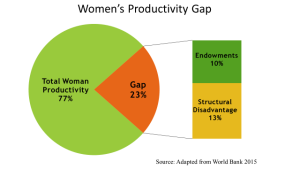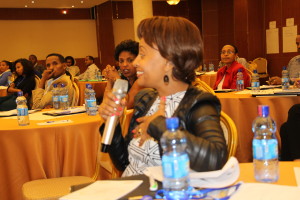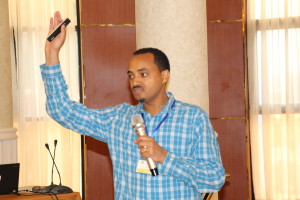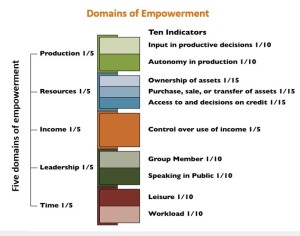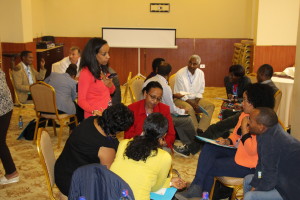Organized in collaboration with IFPRI and the Agricultural Transformation Agency (ATA), this workshop was hosted by the Ministry of Agriculture and Natural Resources – Women’s Affairs Directorate to bring together people from government, development partners, NGOs and research organizations to: a) Learn and to share existing knowledge about gender equality and women’s empowerment in the agricultural sector, and b) Identify directions for future research in Ethiopia.
Approximately 50 participants (65% female and 35% male) gathered on June 17, 2016 to listen to presentations from IFPRI researchers on the findings to date on gender and agriculture, and on the Women Empowerment in Agriculture Index (WEAI) tool, as well as to contribute to future investigations on this important topic for Ethiopia.
Leulsegged Kasa described patterns of agricultural production between male and female holders, considering three aspects: 1) Livelihood asset differences 2) Agricultural input use 3) Livelihood strategy diversity. Through research evidence, he pointed out the significant differences in female holders, noting that women have less capita of land, less use of improved seeds, less chemical fertilizer, less access to extension agents, and less participation in ‘lucrative’ teff production than men. However, to further enhance the quality of data in gender analyses, increasing disaggregation and coverage would go a long way.
Sorsie Gutema from Central Statistical Agency (CSA) further provided a comprehensive overview of the AgSS data and its shortcomings. CSA has been collecting data for decades, but it was only in 2013 that the first specific gender survey was conducted, and intended to reach invisible aspects of gender. This marked an important step, however gaps in the data remain in areas, such as men and women’s preferences, along with the many assumptions made around equitable pooling of resources, work participation and decision-making. Sorcie stated that more gender statistics for policy makers, researchers and advocates are essential to provide the evidence that goes beyond the household, and with further disaggregation of official statistics, additional surveys to address gaps, and more resources, like working through partnerships.
Putting the Gender and Agriculture workshop into context, James Warner focused on the productivity gap and its drivers. He described the complexity surrounding research findings, and the multi-dimensional role women play in the household. According to a report from the World Bank, there exists a 23 percent difference in women’s productivity compared to men, with many elements being interrelated, for example, less access to information services and less education, lack of access to credit and therefore mechanization. In addition to these negative differences, women suffer from cultural norms and practices. To promote the closing of this productivity gap, Warner emphasized that important issues must be addressed, for example, women’s time constraints, easier access to markets that are closer to the family house, and inclusion in action groups.
Having reviewed the data and evidence about gender issues, Fanaye Tadesse and Hazel Malapit spoke about the recently developed WEAI tool, whose purpose is to measure greater inclusion of women in agricultural sector growth. WEAI measures women’s empowerment based on 5 domains – production, resources, income, leadership and time. Within these 5 domains, there are 10 indicators.
Using this framework or tool, it is possible to arrive at an Empowerment Score. Fanaye described the results of WEAI from Ethiopia under the Feed the Future (FtF) initiative. She illustrated that Leadership (34 percent) was the largest contributor to disempowerment, closely followed by Time (28 percent). The disempowerment contributors were similar for both men and women. Fanaye also showed that based on this tool, there appears a gap of 23 percent in empowerment scores between men and women in Ethiopia. But overall, the level of empowerment shows some improvement between the baseline and midline surveys over the 2-year interval. Hazel Malapit focused on studies in Bangladesh – the first country to use the WEAI tool – highlighting the lessons learned. For example, making data available and to share research results early to build ownership, as well as to encourage others to use the data. Like in Bangladesh, Ethiopia has taken on board the lessons learned from this research, embracing the improvements in knowledge about the domains that contribute to empowerment, and thus making it easier to look at the gaps to design specific programmes to help empower women.
During the breakout sessions in the afternoon, people actively participated in small groups and helped gather ideas for future research. Two parallel sessions covered topics including: WEAI and Diet Diversity, Rural Finance and Intra-Household Decision-Making, Women and Coffee Value Chains, Women and Agricultural Technology Use.
The Gender and Agriculture Workshop has helped educate and raise awareness of the facts supporting gender issues, and has highlighted areas for further evidence-based research to validate critical issues that affect women’s disempowerment and the impact of these in today’s society. IFPRI’s research brings current and relevant research topics to the forefront, and in doing so, helps to change women’s lives through modifying policies and practices.
To read more about some of the research presented during the workshop, there are Working Papers, Research Notes and presentation slides available on line.
Please subscribe to receive regular updates on IFPRI’s work.
